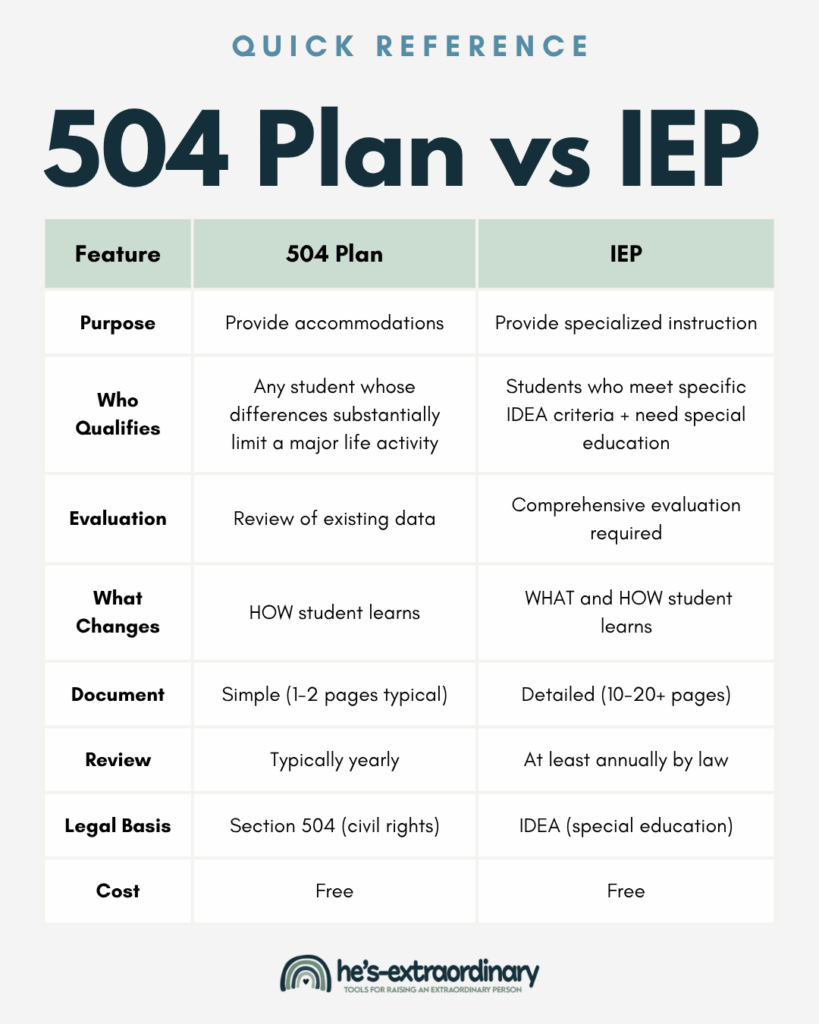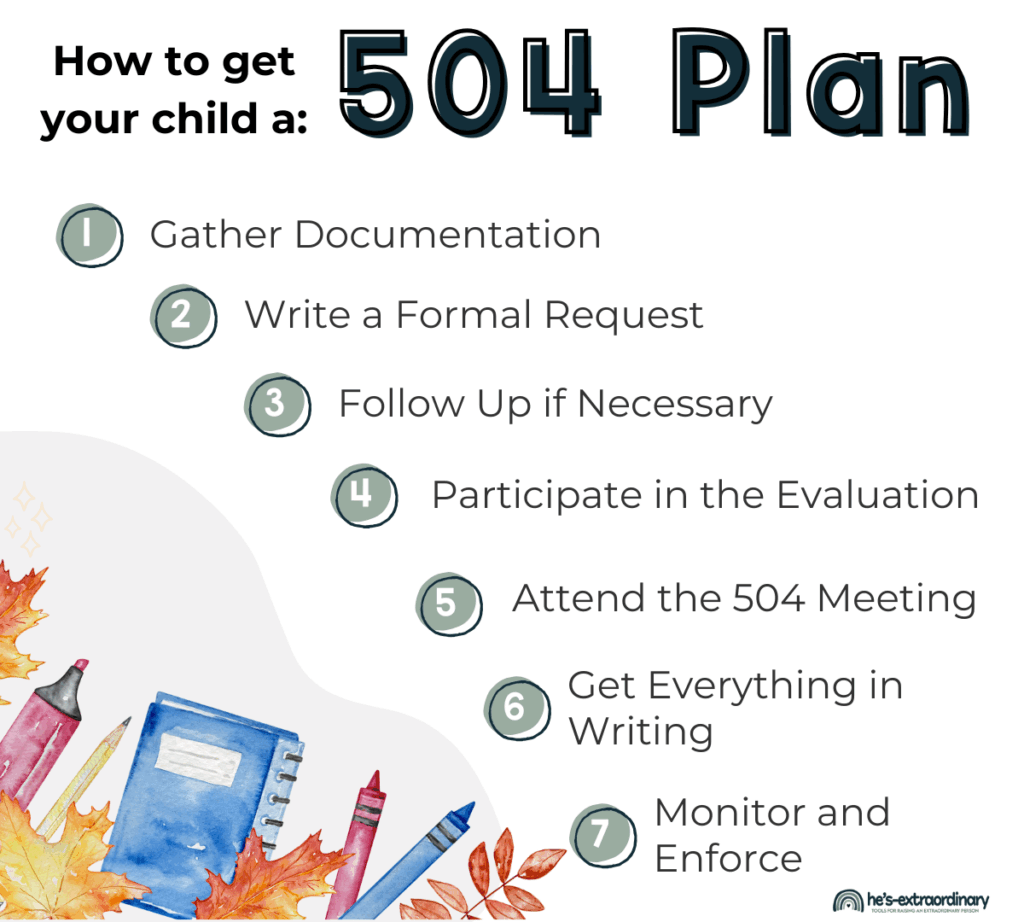What Is A 504 Plan And How Do You Get One For Your Child?
What’s inside this article: Everything you need to know about 504 plans, including what they are, who qualifies (spoiler: you don’t need a diagnosis!), how they differ from IEPs, and the exact steps to get one for your child. Plus, what you need to know about recent changes in 2025.
In some public schools in the United States, anywhere from 20 to 30 percent of students have 504 plans.
Have you wondered whether or not your child could benefit from this kind of support? Are you confused about what 504 plans are or the kinds of accommodations they offer?
If so, read on to learn more, including the steps you need to take to get a 504 plan for your child.
What Is a 504 Plan?
A 504 plan is a formal plan that ensures students who require additional supports at school receive the accommodations they need to be successful.
These plans are intended to remove barriers to learning and level the playing field. They’re available to any student whose needs limit their daily activities or affect their school performance.
This means your child does not need a diagnosis to have a 504 plan.
In addition to accommodating students and giving them the tools they need to succeed, 504 plans also prevent discrimination. They protect students with disabilities and are covered under Section 504 of the Rehabilitation Act, which is a civil rights law that was passed in 1973.
This also means a 504 plan is a legal document that your child’s school is required to follow.
What this means: This law was created by Congress and remains fully in effect. Despite recent news in 2025 about changes to the Department of Education, your child’s rights under Section 504 haven’t changed. Schools are still legally required to provide these accommodations.
Who Can Qualify for a 504 Plan?
Something important that a lot of parents may not know: Your child does NOT need a medical diagnosis to qualify for a 504 plan.
To qualify, your child must have a physical or mental difference that “substantially limits” one or more major life activities.
The key phrase is “substantially limits” – not “diagnosed with.”
Major life activities include:
- Learning
- Reading
- Concentrating
- Thinking
- Communicating
- Walking
- Breathing
- Sleeping
- Eating
- Speaking
- Caring for oneself
This means if your child is struggling with attention and it’s making it hard for them to focus during class, even without an official ADHD diagnosis, they may still qualify.
Or, if anxiety makes it difficult for them to participate in school activities, they may qualify.
If they have differences in how they process written information and it’s impacting their ability to complete assignments, they may qualify.
Having a diagnosis from a doctor certainly helps your case and makes the process smoother. But the lack of one shouldn’t stop you from seeking support if your child needs it.
Common Reasons Students Need 504 Plans
While any difference that substantially limits a major life activity can qualify, here are some common reasons students benefit from 504 plans:
- ADHD
- Anxiety
- Depression
- Learning differences (like dyslexia or dysgraphia)
- Autism
- Food allergies
- Asthma
- Diabetes
- Epilepsy
- Temporary situations (recovery from injury, surgery, or serious illness)
Remember: even if your child maintains good grades, they can still qualify if their neurological or physical differences make learning significantly harder than it is for their peers.
Example 504 Plan Accommodations
504 Plans can include a range of accommodations tailored to your child’s unique needs.
The following are just a few examples:
For Focus and Attention Differences
- Extra time on tests and assignments (usually 1.5x or 2x)
- Breaking large assignments into smaller, manageable chunks
- Scheduled movement breaks every 20-30 minutes
- Preferential seating (away from distractions)
- Written instructions in addition to verbal ones
- Use of fidget tools or standing desk
- Reduced homework load when appropriate
- Permission to use noise-canceling headphones
For Emotional Regulation Needs
- Advance notice of any schedule changes
- Permission to take breaks when feeling overwhelmed
- Alternative presentation options (recorded instead of live)
- Testing in a quiet, separate environment
- Designated safe person/place in school
- Modified participation requirements for group work
- Email check-ins with teachers instead of public questions
- Extended time for transitions between activities
For Learning Differences
- Audio versions of textbooks
- Permission to type instead of handwrite
- Copies of teacher notes or peer notes
- Use of a calculator or multiplication charts
- Spell-check and grammar-check tools allowed
- Oral testing options
- Highlighted or color-coded materials
- Visual schedules and organizers
For Physical or Medical Needs
- Unlimited bathroom access
- Keeping a water bottle at desk
- Snacks for blood sugar management
- Elevator access
- Modified PE requirements
- An extra set of textbooks for home
- Leaving class 5 minutes early to avoid crowds
- Air conditioning for heat sensitivity
For Social Communication Differences
- Lunch in a quieter space
- Structured recess activities
- Social skills group participation
- Pre-teaching of social scenarios
- Modified group work requirements
- Regular check-ins with a counselor
- Peer buddy system
- Advance preparation for changes
For more ideas and examples, read 125+ Student Accommodation Ideas to Help Kids Succeed at School
It’s important to note that students on 504 plans are still learning the same material as their peers. The content of their education doesn’t change, only the way they go about learning it.
504 Plans vs. IEPs – What’s the Difference?
Sometimes parents confuse these two types of support, and honestly, sometimes schools do, too. But a 504 plan is different from an Individualized Education Program (IEP).
Here’s a clear breakdown:
504 Plan
- What it does: Provides accommodations (changes HOW your child learns)
- What it doesn’t change: The curriculum (WHAT your child learns)
- Who qualifies: Any student whose differences substantially limit a major life activity
- Evaluation process: Generally simpler and faster
- Legal basis: Section 504 of the Rehabilitation Act (civil rights law)
- Review schedule: Typically yearly
- Complexity: Usually a 1-2 page document
IEP (Individualized Education Program)
- What it does: Provides specialized instruction and related services
- What it can change: May modify curriculum and learning goals
- Who qualifies: Students who meet specific criteria under IDEA and need specialized instruction
- Evaluation process: Comprehensive evaluation required
- Legal basis: IDEA (Individuals with Disabilities Education Act)
- Review schedule: Must be reviewed at least annually
- Complexity: Detailed document, often 10-20+ pages

Important: You do NOT have to ‘try’ a 504 plan before getting an IEP. If your child needs specialized instruction, don’t let the school pressure you into accepting less than what they need.
Additionally, because the definition of a disability is broader in Section 504 of the Rehabilitation Act, some children who don’t qualify for IEPs can still get help through a 504 plan.
How to Get a 504 Plan: The Step-by-Step Process

If you think your child will benefit from a 504 plan, here are the steps you should take to ensure they get the help they need:
Step 1: Gather Documentation
For your child to receive a 504 plan, they must have documented evidence that they have physical or mental differences that are impacting one or more major life activities.
To begin the process of getting their plan and accommodations, you’ll need to gather records that verify this.
Gather any documentation available, such as:
- Teacher emails mentioning observations
- Work samples showing your child’s unique learning style
- Your own observations (keep a log!)
- Attendance records if anxiety affects school attendance
- Any medical records you do have
- Standardized test scores showing inconsistencies
- Report cards with teacher comments
Remember: You’re showing how your child’s differences “substantially limit” their participation, not proving a specific diagnosis.
Step 2: Write a Formal Request to the School’s 504 Coordinator
Every public school in the United States has a designated staff member who’s responsible for handling 504 plans. They will be instrumental in helping your child access necessary accommodations.
You can typically find this person’s contact information on the school district’s website, or you can ask your child’s teacher or the school principal.
Here’s an email template you can use:
504 Plan Evaluation Request Email Template
Subject: Request for 504 Plan Evaluation – [Child’s Name]
Dear [Name],
I am writing to formally request a 504 plan evaluation for my [son/daughter], [Child’s Name], who is in [Teacher’s Name]’s [grade] grade class at [School Name].
[Child’s Name] has differences in [brief description, such as “how they process information and maintain focus” or “how they experience and manage emotions in the school environment”].
These differences substantially limit their ability to [specific major life activity, such as “learn,” “concentrate,” or “participate in school activities”] compared to other students.
Specific examples include:
- [Specific example 1]
- [Specific example 2]
- [Specific example 3]
[If applicable: I am attaching documentation from [source] that supports these observations.]
Please begin the 504 evaluation process as soon as possible. I am available to discuss this further and provide any additional information needed.
Thank you for your attention to this matter.
Sincerely, [Your name] [Date]
Step 3: Follow Up if Necessary
Ideally, you’ll hear back right away from the school district’s 504 coordinator after submitting your request.
However, if you don’t get a reply within 5 school days:
- Send a follow-up email
- Call the main office
- Visit in person if needed
Schools may be overwhelmed but they’re still required to meet your child’s educational needs. So, if you don’t hear back, your persistence isn’t being difficult – it’s advocating for your child.
Step 4: Participate in the Evaluation
Technically, your child does not need a formal evaluation to receive a 504 plan. However, the 504 coordinator will likely want to do some assessing of their own before approving your request.
They may gather information to determine eligibility, such as:
- Reviewing your documentation
- Observing your child in class
- Looking at grades and test scores
- Talking to teachers
- Reviewing behavior records
Stay involved! You can:
- Ask what they’re evaluating
- Provide additional examples
- Request specific assessments
- Share what you see at home
Step 5: Attend the 504 Meeting
After the evaluation, the 504 coordinator will meet with you to discuss your child’s needs in more depth and let you know if they think a 504 plan is the right solution to their learning challenges.
This is a good opportunity for you to ask additional questions about what the plan entails or how the school is going to support your child.
Then, you’ll collaborate with the 504 coordinator, your child’s teacher, and other representatives from the school to create a plan that centers your child and accommodates their needs.
Every 504 plan is unique and tailored to the child’s individual needs. However, if you’re unsure of where to start, there are plenty of templates available online that you can reference.
Bring:
- List of specific accommodations you want
- Examples of what has/hasn’t worked
- Questions about implementation
- A support person if you want one
Ask:
- What happens if accommodations aren’t followed?
- Who ensures that accommodations are implemented?
- How will we measure if they’re working?
- When will we review and update?
It can feel overwhelming sitting around a table with the school staff, especially if your child regularly encounters behavior challenges. You can bring an advocate with you if you feel like you need one to help you in advocating for your child.
Step 6: Get Everything in Writing
While not technically required, insist on a written plan that includes:
- Each specific accommodation
- Who’s responsible for implementing them
- How you’ll track effectiveness
- Review date
- Contact person for concerns
Step 7: Monitor and Enforce
A 504 plan only works if it’s followed. Stay on top of it:
First week of school:
- Email each teacher confirming they have the plan
- Ask how they’ll implement specific accommodations
Ongoing:
- Check in with your child weekly
- Document any missed accommodations
- Address concerns immediately with teachers
- Escalate to 504 coordinator if needed
Red flags to watch for:
- Accommodations only happening sometimes
- “We don’t do that in my class”
- “They seem fine without it”
- “Other kids will think it’s unfair”

504 Plans in Private Schools: What You Need to Know
The rules are different for private schools:
Private Schools That Receive Federal Funding
If a private school receives ANY federal funding (including lunch programs, Title I funds, or federal grants), they must:
- Provide 504 plans to qualified students
- Follow the same non-discrimination rules as public schools
- Make reasonable accommodations
Private Schools Without Federal Funding
These schools have minimal obligations:
- Only required to make “minor adjustments”
- Not required to provide formal 504 plans
- May have their own accommodation policies
- Still can’t discriminate under ADA
How to find out: Ask the school directly about federal funding, or check their annual report for funding sources.
Current Status: What the 2025 Changes Mean for Your Child
You might be worried about recent news regarding the Department of Education. Here’s what you need to know:
What HASN’T changed:
- Section 504 is still federal law
- Schools must still provide 504 plans
- The evaluation process remains the same
- Your child’s existing plan continues
What to watch:
- Enforcement and oversight may shift to different agencies
- Some administrative processes might change
- Continue advocating as you always have
Bottom line: The process at your local school continues as normal. Don’t let political uncertainty stop you from getting your child the support they need right now.
Making 504 Plans Work in Real Life
Getting the plan is just the beginning. Here’s how to ensure success:
Build Relationships
- Meet teachers before school starts
- Share what works for your child
- Maintain regular communication
- Thank teachers who implement well
Teach Self-Advocacy
Self-advocacy is the ability to recognize your needs, preferences , and boundaries and to express those needs in a way that they get met.
The better your child is at advocating for themselves, the better they’ll be at having their needs met at school.
Here are some helpful resources:
- 10 Ways to Support Self-Advocacy at Home
- Guide: Teaching Self-Advocacy to Neurodivergent Kids
- How to Teach Kids to Advocate for Their Sensory Needs
- How an OT Can Help Your Child Build Self-Advocacy Skills
Review and Revise
- Formal review at least yearly
- Request updates anytime needs change
- Remove accommodations no longer needed
- Add new ones as challenges emerge
Common Situations and Solutions
“The school says they don’t think my child qualifies.”
- Request the denial in writing
- Ask for specific reasons
- Provide additional documentation
- Consider an independent evaluation
“Teachers aren’t following the plan.”
- Document each instance
- Email the teacher (create a paper trail)
- Copy the 504 coordinator
- Request a team meeting if it continues
“My child is embarrassed by accommodations.”
- Discuss how accommodations level the playing field
- Work on age-appropriate self-advocacy
- Consider more discrete accommodations
- Involve your child in plan decisions
When a 504 Plan Isn’t Enough
Consider requesting an IEP evaluation if:
- Accommodations aren’t providing enough support
- Your child needs direct instruction in specific skills
- They need a different approach to learning
- Their needs require more intensive support
- They need related services (speech, OT, counseling)
Remember: Your child’s success matters more than which type of plan they have.
Helpful Resources
For strategies and activities:
- 125+ Student Accommodation Ideas
- Working Memory Activities and Support
- 85 Play-Based Fine Motor Activities
- Bilateral Coordination Exercises
For legal support:
- Office for Civil Rights (handles 504 complaints)
- Your state’s Protection & Advocacy organization
- Council of Parent Attorneys and Advocates (COPAA)
- Local disability rights organizations
Get Started Today
Your child’s education can’t wait for political changes or perfect timing. If your child needs additional support, they deserve it now.
Remember:
- You don’t need a diagnosis to request evaluation
- The law still protects your child’s rights
- Schools are still required to provide accommodations
- Your advocacy makes the difference
Take the first step today. Write that email. Make that call. Your child deserves every opportunity to succeed, and you have the power to make it happen.
You’ve got this. And your child is lucky to have you fighting for them.

